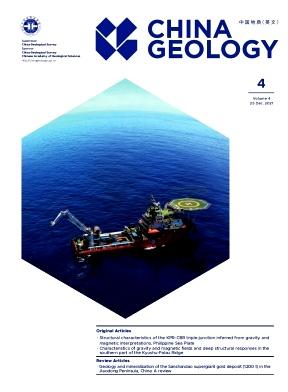Iron-manganese modified corncob biochar for fluoride removal from groundwater: Insights into adsorption mechanisms
IF 4.7
3区 地球科学
Q1 GEOSCIENCES, MULTIDISCIPLINARY
引用次数: 0
Abstract
Biochar, as an efficient, effective, and potential soil improver, has broad application prospects in the field of defluoridation. This study aimed to evaluate the defluoridation potential of iron (Fe) and manganese (Mn) co-modified biochar from groundwater. The varied Fe/Mn molar ratio (2:1 and 1:2) modified biochar was prepared by corncob with the pyrolysis temperature of 300°C, 400°C, and 500°C. Batch experiments for fluoride (F‒) removal were performed by corncob biochar before and after Fe–Mn modified. Their composition, structure, and performance were analyzed by multiple characterization techniques to clarify F‒ removal mechanisms. Our results indicated that unmodified corncob biochar produced at 400 °C (BC400) exhibited the highest F‒ adsorption efficiency (87.3%) among three unmodified samples, attributable to its largest specific surface area (2.55 m2/g). Notably, F‒ removal amounts by Fe-Mn modified BC400 were 2 times higher than BC400. The enhanced F- removal performance of Fe–Mn modified biochar can be attributed to several mechanisms: (1) the modification produced rougher surface textures, resulting in an increased specific surface area (about 3.50 m2/g); (2) newly formed Fe–O and Mn–O bonds on the biochar surface facilitated the formation of complexes with F‒; and (3) the adsorption results fitted well with pseudo-second-order and Freundlich models (R2>0.98), indicating that the removal process involved physicochemical adsorption. These findings demonstrate that Fe–Mn modified biochar is a highly efficient and cost-effective material for F‒ remediation and holds significant potential for application in contaminated groundwater and soil systems.
铁锰改性玉米芯生物炭去除地下水中的氟化物:对吸附机制的见解
生物炭作为一种高效、有效、潜力巨大的土壤改良剂,在除氟领域有着广阔的应用前景。本研究旨在评价地下水中铁(Fe)和锰(Mn)共改性生物炭的除氟潜力。以玉米芯为原料,热解温度分别为300℃、400℃和500℃,制备了Fe/Mn摩尔比(2:1和1:2)不同的改性生物炭。采用Fe-Mn改性前后的玉米芯生物炭进行了脱除氟的批量实验。通过多种表征技术分析了它们的组成、结构和性能,以阐明F -的去除机理。结果表明,在400°C条件下制备的未改性玉米芯生物炭(BC400)具有最大的比表面积(2.55 m2/g),其F -吸附效率最高(87.3%)。值得注意的是,Fe-Mn改性BC400对F的去除率是BC400的2倍。Fe-Mn改性生物炭除氟性能的增强可归因于以下几个机制:(1)改性产生了更粗糙的表面结构,导致比表面积增加(约3.50 m2/g);(2)生物炭表面新形成的Fe-O和Mn-O键有利于与F -形成配合物;(3)吸附结果符合拟二阶和Freundlich模型(R2>0.98),表明吸附过程为物理化学吸附。这些研究结果表明,铁锰改性生物炭是一种高效、经济的氟修复材料,在污染地下水和土壤系统中具有重要的应用潜力。
本文章由计算机程序翻译,如有差异,请以英文原文为准。
求助全文
约1分钟内获得全文
求助全文

 求助内容:
求助内容: 应助结果提醒方式:
应助结果提醒方式:


